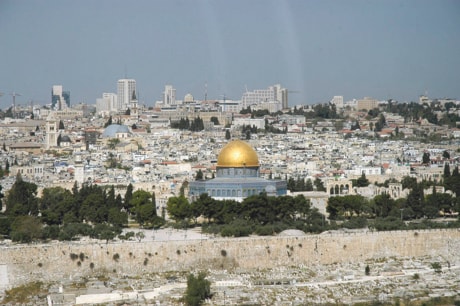JERUSALEM, Israel — There is a narrow alleyway in the Arab district of this holy, ancient city, not unlike many others that wind and curve and fill every centimetre of available space.
Perhaps it has a name, perhaps it doesn’t. The people who shop here know to stop at this stall for the delicate spice za’atar, at the other one for scarves or lace tablecloths.
They know that here is the vendor who sells gelatinous candy that is sure to delight the children, and that one can be counted on to give a fair measure of incense for the shekel.
The alley bustles with commerce: Men selling spices with Biblical names, spilling from clay bowls; a gently smiling vendor in a worn suit making tea at his push cart; soldiers laughing and as they stride through the market.
A hole-in-the-wall restaurant serves up platters of hummus, deep-fried meat dumplings and falafel, all of it washed down with cans of cold Coke.
Outside, just a few steps across the alley, the Roman numeral V is carved in a wall. This is the fifth station of the cross, the place where Simon of Cyrene carried the cross after Christ had been sentenced to death.
Right next to it, an Arab shopkeeper sells carpets, children play and history, unless you are a devout Christian, takes a back seat to modern life.
But this area is also the site of the Via Doloroso, or the Way of Sorrows, the path Christians believe Jesus followed from condemnation to death to burial.
The last stations are contained inside the Church of the Holy Sepulchre at Golgotha, a church now divided between six Christian sects. It is here that the Stone of Unction, where Christ’s body is said to have been laid after crucifixion, is placed. The church is also said to hold Golgotha, where Christ was crucified.
The church is filled with both pilgrims and the curious, holy and awe-inspiring to the devout, and still magnificent to those who appreciate the beauty and enduring power of the site.
The roof of the church (over the Chapel of St. Helena) remains under the divided power of the Coptic and Ethiopian Orthodox sects. Ethiopian monks sit placidly, their black shirts drying on lines under the bright sun, apparently oblivious to any dispute.
The old city of Jerusalem is encased by a 12-metre-high wall built in 1538. The Western Wall (also known as the Wailing Wall) is a site that people of all faiths visit. Men and women pray on divided sides.
The plaza in front of the Wall is where bar mitzvahs are conducted, and where soldiers who have finished boot camp come to swear to defend Israel with their lives.
Again, faith is irrelevant as you observe the heartfelt prayers, the observant Jews making their slow way across the plaza, and the hundreds of crumpled papers holding the prayers of the faithful, crammed into nooks and crannies.
Couples pose for wedding photos, and women with their Torahs held close to their faces pray with fervour.
A somewhat lesser-known attraction is the Western Wall tunnels, a tour behind the wall and beyond. From the time of the Temple’s initial destruction, the Wall symbolized the history of the Jewish faith. The Wall tunnels, whose excavations began in 1967, take visitors behind the Wall itself. Ancient times come to life.
This is a journey back 2,000 years, and one that believers are convinced exposes the Ark of the Covenant, where the original Ten Commandments were kept.
“No other city is like Jerusalem,” says tourism expert Eli Nahmas. “All the religions, all the cultures, all the museums. It is all here.”
“In Jerusalem, legend and faith are intertwined.”
Indeed, while atheists could happily come to Jerusalem for the history and the beauty, the point seems to be lost. Legend starts here, faith has its root and tradition its genesis.
The Jewish Quarter, which lies directly west of the majestic Temple Mount, has been rebuilt and revitalized, most recently after the 1967 war.
History is at every turn in the old city. The Cardo Maximus, recently excavated, was the main street dating back to the second century AD.
The Temple Mount, now an Islamic mosque, can be visited Sunday through Thursday mornings.
To properly see the old city, book a walking tour. Leave time to wander through the markets and bazaars, to linger over coffee and to taste food.
There is much to see in the more modern parts of Jerusalem, but most tourists will come for the history, perhaps to reaffirm their faith, and for the reflection of what can be built and destroyed in the name of God.
